If you’ve ever pulled your favorite wool socks out of the dryer only to find they shrank or felted, you’re not alone.
Wool is strong yet unforgiving — the way you dry it determines how long it stays soft and fitted.
This guide explains exactly how to dry wool socks safely, avoid shrinkage, and keep that cozy feel wash after wash.
Quick Answer: Do Wool Socks Dry Quickly?
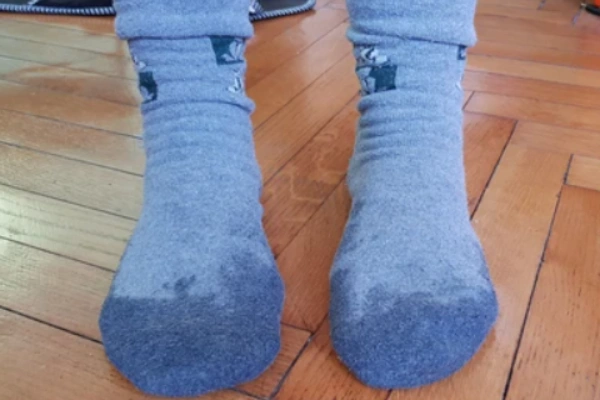
No, wool socks generally do not dry quickly, especially when compared to synthetic or cotton socks. Wool socks take longer to dry than cotton or synthetics because wool fibers can hold up to 30 % of their weight in moisture.
That absorbency keeps your feet dry but slows the drying process.
For faster results, avoid high heat — instead, use a towel-roll or fan method to remove moisture safely.
Why Is Proper Drying Important for Wool Socks?
Improper drying causes three main issues:
- Shrinkage: heat and agitation contract fibers.
- Loss of Softness: over-drying removes natural oils, making wool stiff.
- Damage to Fibers: wringing or rough surfaces break delicate strands.
Handle wool gently, keep heat low, and dry flat to preserve softness, shape, and elasticity.
The Best Methods for Drying Wool Socks Safely

When it comes to drying wool socks, there are a few methods you can use to avoid damaging them. The best methods for drying wool socks involve gentle handling and avoiding direct heat sources. Here’s a breakdown of the top techniques to ensure your socks stay in tip-top condition.
Best Methods for Drying Wool Socks:
- Air Drying (Safest): Lay socks flat on a clean towel or rack in a shaded, well-ventilated area.
- Avoid hanging by the cuff — wet weight can stretch the opening.
- Using a Dryer Low Heat (Optional): Use the lowest or wool-specific setting for 10-15 minutes, then remove while slightly damp and finish flat.
- Tumble Dry with Wool-Specific Settings: Modern dryers often have a “Wool Care” option — short, low-temperature, gentle tumbling. Use only when necessary; air drying remains the safest.
Can Wool Socks Be Dried in a Dryer?
Drying wool socks in a dryer is often considered risky. When done correctly, you can dry wool socks in the dryer without causing significant damage. The key is to use the lowest possible heat setting and to monitor the drying process carefully.

Tips for Using the Dryer Safely:
- Place in a mesh bag: To prevent friction and protect the wool fibers, place your wool socks (especially Smartwool and Darn Tough which often contain fine merino) inside a mesh laundry bag before putting them in the dryer. This will reduces friction and pilling.
- Use low heat or wool settings: If you must use a dryer, always opt for the lowest heat setting or the wool-specific cycle, which is designed to protect delicate fabrics. (Ensure the setting is “tumble dry low” or “no heat”.)
- Avoid over-drying: Wool socks should only be dried for the shortest time possible. Over-drying can cause them to shrink or lose their softness. Check on the socks every few minutes to avoid damage.
How Do You Prevent Wool Socks from Shrinking?
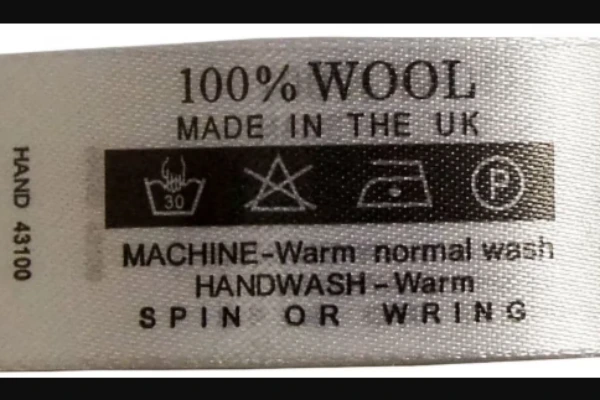
Wool socks are prone to shrinkage if exposed to high heat or harsh drying methods. There are simple steps you can take to prevent shrinkage and keep your wool socks in great shape.
Steps to Prevent Shrinking:
- Avoid high temperatures: Always wash wool socks in cold or lukewarm water and dry them using the gentlest method, either air drying or using a dryer on a low heat setting.
- Check the care label: Always check the care label on your wool socks to understand the recommended temperature ranges for washing and drying. This helps prevent shrinkage and ensures you’re following the manufacturer’s care instructions.
- Choose wool blends: Some wool socks are blended with synthetic fibers like nylon or spandex, which can make them more resistant to shrinking. Consider these blends if you want a more durable option.
How to Maintain the Softness of Wool Socks After Drying?
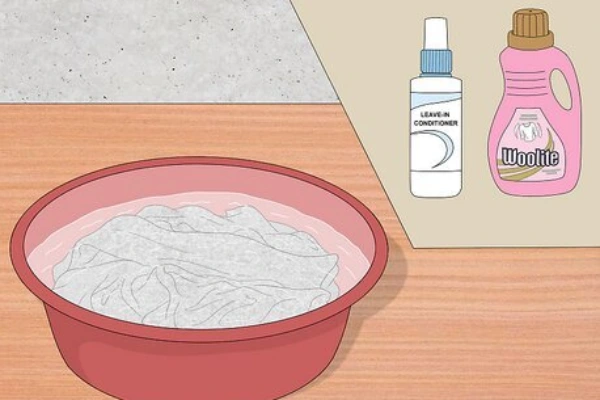
One of the key advantages of wool socks is their softness, which makes them comfortable to wear for extended periods. The softness of wool can be affected by improper drying, which is why maintaining its soft texture after drying is essential. Here are a few simple tips to ensure your wool socks remain soft and comfortable.
Tips for Maintaining Softness:
- Use wool conditioner or wool-safe detergent.
- Avoid fabric softeners and bleach.
- Air dry flat — no heat, no sunlight.
By following these simple steps, you can maintain the softness of your wool socks and continue to enjoy their comfort. Wool socks are an investment in comfort, so it’s worth taking the time to care for them properly to extend their life.
Common Mistakes to Avoid When Drying Wool Socks
Quick, actionable fixes for the issues we see most often in manufacturing and after-sales.
| Mistake | How to Avoid / Fix It |
|---|---|
| Using high heat | Dry on low heat or air-dry only. |
| Wringing out socks | Press between towels; never twist. |
| Drying on rough surfaces | Lay on a soft towel or mesh rack. |
| Direct sunlight | Dry in shade with good airflow. |
| Over-drying in a dryer Common | Stop early while slightly damp; finish flat. |
| Poor ventilation | Use a fan or dehumidifier / airy room. |
| Ignoring the care label | Follow temperature & cycle instructions. |
| Not reshaping after wash | Reshape cuffs/toes while damp. |
| Stacking wet socks | Lay flat individually for even drying. |
| Harsh detergents / softeners | Use mild wool detergent only. |
By avoiding these common mistakes, you can extend the life of your wool socks and keep them looking and feeling like new.
Can Wool Socks Be Dried Outdoors?
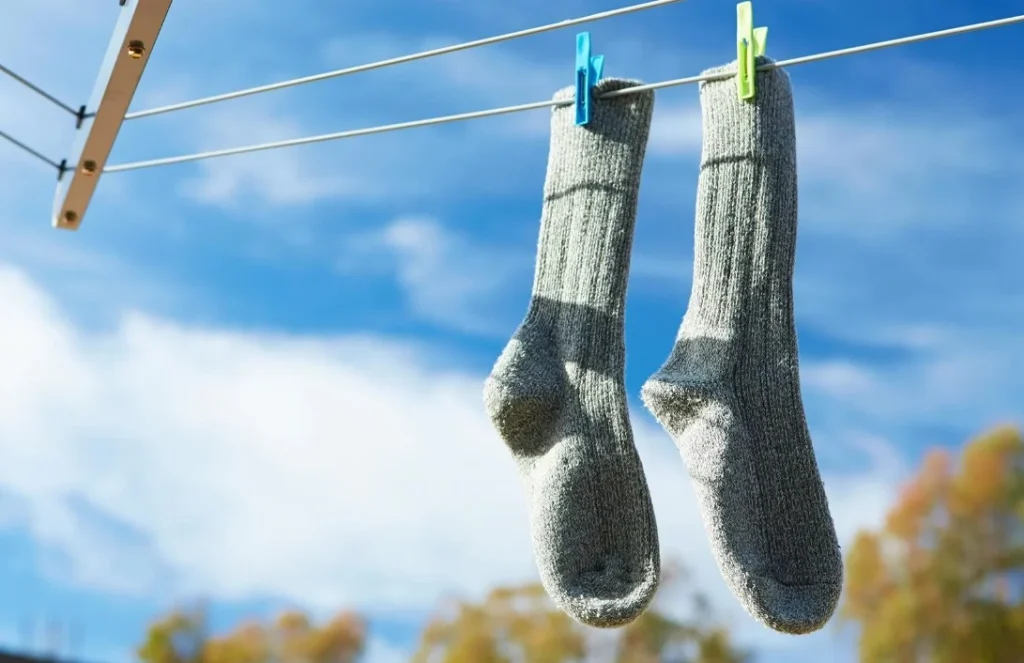
Drying wool socks outdoors can be an effective and natural way to dry them, especially if you live in a dry, sunny climate. Outdoor drying has its benefits, but it also requires a little more care to avoid potential damage to the wool fibers. Let’s explore the pros and cons of drying wool socks outside.
Benefits of Outdoor Drying:
- Fresh air and natural drying: Outdoor drying allows your wool socks to dry naturally in fresh air, which is gentler on the fibers compared to using a dryer. The process is slower, but it prevents the wool from becoming brittle or shrunken.
- Sunlight exposure: While sunlight can help dry socks faster, direct sunlight can also cause the color to fade and weaken the wool fibers over time. To prevent this, dry wool socks in a shaded area to protect them from UV rays.
- Eco-friendly: Drying wool socks outside is an environmentally friendly option, as it uses no energy from appliances, reducing your carbon footprint.
Risks of Outdoor Drying:
- Exposure to dirt or pests: One of the risks of drying wool socks outdoors is the potential for dirt, dust, or insects to land on them. Ensure the drying area is clean and free from debris to avoid contamination.
- Weather dependency: Outdoor drying is also weather-dependent. Rain, high humidity, or strong winds can disrupt the drying process, potentially causing the socks to take longer to dry or become damp again.
How Does Humidity Affect the Drying of Wool Socks?
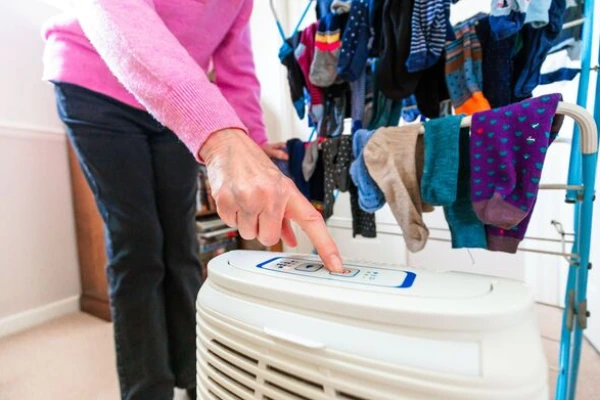
Humidity can significantly impact how quickly your wool socks dry and the overall effectiveness of the drying process. If you live in a humid climate, drying wool socks can take longer, and the high moisture levels can cause the socks to retain dampness for extended periods, potentially leading to unpleasant odors.
How Humidity Affects Wool Socks:
- Longer drying times: In high humidity, wool socks will take much longer to dry. The moisture in the air prevents the wool from fully evaporating, leaving socks damp for an extended period. This is why air drying can take several days in humid conditions.
- Risk of mildew: When wool socks stay damp for too long in humid environments, they can develop mildew or mold, which not only smells bad but can also cause permanent damage to the fabric.
- Stubborn odor: If wool socks do not dry properly, they may develop a musty or sour smell. Humidity makes it harder for socks to completely dry, especially if they are left in a confined, non-ventilated area.
How to Speed Up Drying in Humid Conditions:
- Use a fan or dehumidifier: If you live in a humid environment, consider using a fan or dehumidifier to speed up the drying process. These tools help reduce moisture in the air and increase airflow, allowing your socks to dry faster.
- Move to a dry room: If possible, move your wool socks to a room with lower humidity or better ventilation. This will prevent moisture buildup and help your socks dry more efficiently.
By understanding how humidity affects the drying process, you can take steps to mitigate its impact and ensure that your wool socks dry properly.
Long-Term Benefits of Properly Drying
- Increased lifespan: Proper drying prevents wool from becoming damaged, which helps extend the lifespan of your socks. Wool socks can last much longer when they are air-dried or dried using low heat settings.
- Maintained softness: By avoiding harsh drying techniques, you can keep wool socks soft and comfortable. This is especially important for socks worn frequently.
- Preserved elasticity: Drying wool socks properly helps maintain the natural stretch and elasticity of the fabric, ensuring they continue to fit well over time.
FAQ
What is the absolute safest method for drying wool socks?
The safest method is air drying wool socks by laying them flat on a clean towel or drying rack. This prevents heat damage and stretching, which are the main causes of shrinkage in wool.
Can I put merino wool socks in the dryer without them shrinking?
You can use a dryer, but you must use the lowest or “no heat” setting (tumble dry low). For merino wool socks, air drying is strongly preferred, as any heat or heavy agitation risks shrinkage and fiber damage.
How can I quickly dry my wool socks, especially when traveling?
To quickly dry your wool socks, first roll them tightly in a clean, dry towel to absorb excess moisture (the “burrito method”). Then, lay them flat in front of a fan or in a well-ventilated, warm space.
Should I hang wool socks to air dry?
No, you should avoid hanging wool socks by their cuffs, especially when they are wet. The weight of the water can stretch the fabric and ruin the shape and fit of the sock. Always lay them flat for proper drying wool socks.
Do specific brands like Smartwool or Darn Tough require special drying care?
Yes, for brands like Smartwool or Darn Tough, always default to tumble dry low or air drying flat. Following the care label ensures the longevity of the synthetic blends and keeps the product warranty valid.
